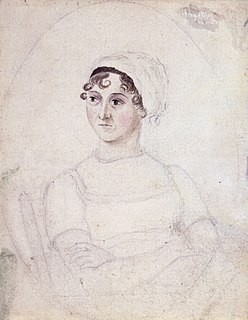Related Research Articles

Jane Austen was an English novelist known primarily for her six major novels, which interpret, critique and comment upon the British landed gentry at the end of the 18th century. Austen's plots often explore the dependence of women on marriage in the pursuit of favourable social standing and economic security. Her works critique the novels of sensibility of the second half of the 18th century and are part of the transition to 19th-century literary realism. Her use of biting irony, along with her realism, humour, and social commentary, have long earned her acclaim among critics, scholars, and popular audiences alike.

Firewood is any wooden material that is gathered and used for fuel. Generally, firewood is not highly processed and is in some sort of recognizable log or branch form, compared to other forms of wood fuel like pellets or chips. Firewood can be seasoned (dry) or unseasoned (fresh/wet). It is generally classified as hardwood or softwood.
Rachel Hunter was an English woman novelist of the early 19th century who lived and worked in Norwich. She was a contemporary of Jane Austen.

Netley, officially referred to as Netley Abbey, is a village on the south coast of Hampshire, England. It is situated to the south-east of the city of Southampton, and flanked on one side by the ruins of Netley Abbey and on the other by the Royal Victoria Country Park.
Martha Lloyd was Jane Austen's dearest friend after Austen's sister Cassandra, and is now known also as a collector of recipes.

Thomas Langlois Lefroy was an Irish-Huguenot politician and judge. He served as an MP for the constituency of Dublin University in 1830–1841, Privy Councillor of Ireland in 1835–1869 and Lord Chief Justice of Ireland in 1852–1866.

The reception history of Jane Austen follows a path from modest fame to wild popularity. Jane Austen (1775–1817), the author of such works as Pride and Prejudice (1813) and Emma (1815), has become one of the best-known and most widely read novelists in the English language. Her novels are the subject of intense scholarly study and the centre of a diverse fan culture.

Jane Austen lived her entire life as part of a family located socially and economically on the lower fringes of the English gentry. The Rev. George Austen and Cassandra Leigh, Jane Austen's parents, lived in Steventon, Hampshire, where Rev. Austen was the rector of the Anglican parish from 1765 until 1801. Jane Austen's immediate family was large and close-knit. She had six brothers—James, George, Charles, Francis, Henry, and Edward—and a beloved older sister, Cassandra. Austen's brother Edward was adopted by Thomas and Elizabeth Knight and eventually inherited their estates at Godmersham, Kent, and Chawton, Hampshire. In 1801, Rev. Austen retired from the ministry and moved his family to Bath, Somerset. He died in 1805 and for the next four years, Jane, Cassandra, and their mother lived first in rented quarters and then in Southampton where they shared a house with Frank Austen's family. During these unsettled years, they spent much time visiting various branches of the family. In 1809, Jane, Cassandra, and their mother moved permanently into a large "cottage" in Chawton village that was part of Edward's nearby estate. Austen lived at Chawton until she moved to Winchester for medical treatment shortly before her death in 1817.
The History of England is a 1791 work by Jane Austen, written when the author was fifteen.

A Memoir of Jane Austen is a biography of the novelist Jane Austen (1775–1817) published in 1869 by her nephew James Edward Austen-Leigh. A second edition was published in 1871 which included previously unpublished Jane Austen writings. A family project, the biography was written by James Edward Austen-Leigh but owed much to the recollections of Jane Austen's many relatives. However, it was the decisions of her sister, Cassandra Austen, to destroy many of Jane's letters after her death that shaped the material available for the biography.

Eliza Capot, Comtesse de Feuillide was the cousin, and later sister-in-law, of novelist Jane Austen. She is believed to have been inspirational for a number of Austen's works, such as Love and Freindship, Henry and Eliza, Lady Susan and Mansfield Park. She may have also been the model from whom the character of Mary Crawford is derived.
Henry Tilney is the leading man in Jane Austen's 1817 novel Northanger Abbey. The younger son of a local landowner, Tilney is comfortably placed as a beneficed clergyman on his father's estate.

Oakley Hall is a Georgian manor in Oakley, Hampshire, located 10 km (6.2 mi) to the west of Basingstoke. Completed in 1795 by Wither Bramston, the building is now a hotel and conference centre. It is located in a wooded park intersected by the former South Western railway.
Deirdre Le Faye was an English writer and literary critic. She was born in Bournemouth and raised in Farnborough and Reading, during the bombing raids of the Second World War. After her father died of illness, she left school at 16 and began a secretarial course as a scholarship student. She began work as an administrative assistant for the Department of Medieval & Later Antiquities at the British Museum.

The Fishmore Hall Hotel in Ludlow, Shropshire is a house of historical significance. A major part of it was built in about 1820 but some of the building may be older than this. It was a private residence for many years and in the late part of the 20th century it became a school. It was recently converted to a hotel.
George Wickham is a fictional character created by Jane Austen who appears in her 1813 novel Pride and Prejudice. George Wickham is introduced as a militia officer who has a shared history with Mr. Darcy. Wickham's charming demeanour and his story of being badly treated by Darcy attracts the sympathy of the heroine, Elizabeth Bennet, to the point that she is warned by her aunt not to fall in love and marry him. It is revealed through the course of the story that George Wickham's true nature is that of a manipulative unprincipled layabout, a ne'er-do-well wastrel, compulsive liar and a degenerate, compulsive gambler, a seducer and a libertine, living the lifestyle of a rake. Lacking the finances to pay for his lifestyle, he gambles regularly and cons credit from tradesmen and shopkeepers and skips out on paying-up.

Jane Austen's parents, George (1731–1805), an Anglican rector, and his wife Cassandra (1739–1827), were members of the landed gentry. George was descended from wool manufacturers who had risen to the lower ranks of the gentry, and Cassandra was a member of the aristocratic Leigh family. They married on 26 April 1764 at Walcot Church in Bath. From 1765 to 1801, George was a rector of Anglican parishes in Steventon, Hampshire and a nearby village. Irene Collins estimates that when George Austen took up his duties as rector in 1764, Steventon comprised no more than about thirty families. From 1773 to 1796, he supplemented his income by farming and teaching three or four boys at a time.
Miss Bates is a supporting character in Jane Austen's 1815 novel Emma. Shabby genteel, and a compulsive talker, she is memorably insulted on one occasion by the book's heroine, to the latter's almost immediate remorse.
Anna Austen Lefroy (1793-1872) was the niece of Jane Austen by her eldest brother James Austen, and a contributor to her life-history via the so-called Lefroy MS.
Billet (wood) was a specific and standardised form of wood fuel of significant importance in the traditional pre-fossil fuel economy. The term could also be applied to a cudgel.